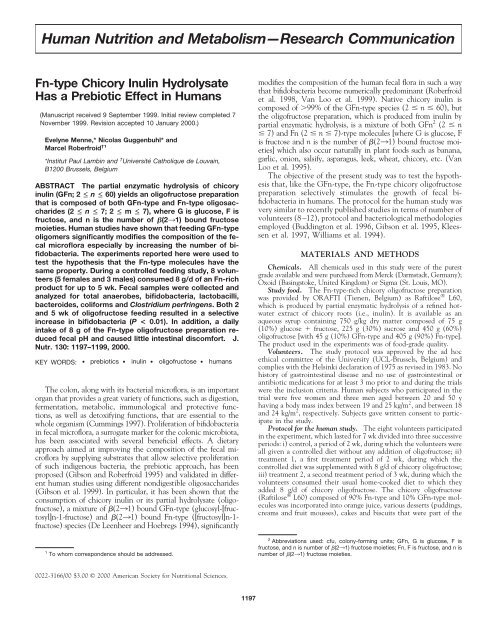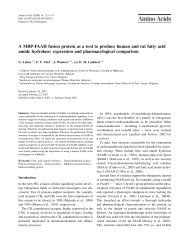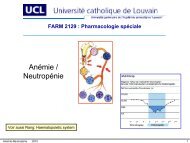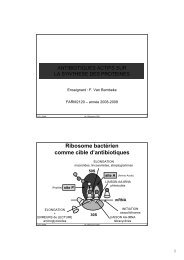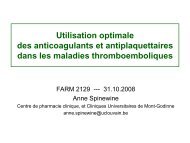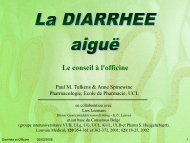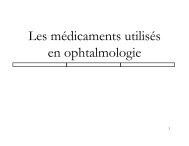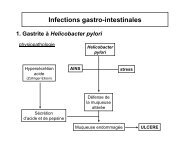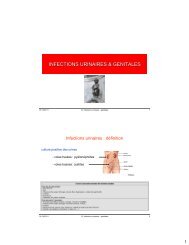Fn-type Chicory Inulin Hydrolysate Has a Prebiotic Effect in Humans
Fn-type Chicory Inulin Hydrolysate Has a Prebiotic Effect in Humans
Fn-type Chicory Inulin Hydrolysate Has a Prebiotic Effect in Humans
Create successful ePaper yourself
Turn your PDF publications into a flip-book with our unique Google optimized e-Paper software.
Human Nutrition and Metabolism—Research Communication<br />
<strong>Fn</strong>-<strong>type</strong> <strong>Chicory</strong> <strong>Inul<strong>in</strong></strong> <strong>Hydrolysate</strong><br />
<strong>Has</strong> a <strong>Prebiotic</strong> <strong>Effect</strong> <strong>in</strong> <strong>Humans</strong><br />
(Manuscript received 9 September 1999. Initial review completed 7<br />
November 1999. Revision accepted 10 January 2000.)<br />
Evelyne Menne,* Nicolas Guggenbuhl* and<br />
Marcel Roberfroid †1<br />
*Institut Paul Lamb<strong>in</strong> and † Université Catholique de Louva<strong>in</strong>,<br />
B1200 Brussels, Belgium<br />
ABSTRACT The partial enzymatic hydrolysis of chicory<br />
<strong>in</strong>ul<strong>in</strong> (G<strong>Fn</strong>; 2 ≤ n ≤ 60) yields an oligofructose preparation<br />
that is composed of both G<strong>Fn</strong>-<strong>type</strong> and <strong>Fn</strong>-<strong>type</strong> oligosaccharides<br />
(2 ≤ n ≤ 7; 2 ≤ m ≤ 7), where G is glucose, F is<br />
fructose, and n is the number of (231) bound fructose<br />
moieties. Human studies have shown that feed<strong>in</strong>g G<strong>Fn</strong>-<strong>type</strong><br />
oligomers significantly modifies the composition of the fecal<br />
microflora especially by <strong>in</strong>creas<strong>in</strong>g the number of bifidobacteria.<br />
The experiments reported here were used to<br />
test the hypothesis that the <strong>Fn</strong>-<strong>type</strong> molecules have the<br />
same property. Dur<strong>in</strong>g a controlled feed<strong>in</strong>g study, 8 volunteers<br />
(5 females and 3 males) consumed 8 g/d of an <strong>Fn</strong>-rich<br />
product for up to 5 wk. Fecal samples were collected and<br />
analyzed for total anaerobes, bifidobacteria, lactobacilli,<br />
bacteroides, coliforms and Clostridium perfr<strong>in</strong>gens. Both 2<br />
and 5 wk of oligofructose feed<strong>in</strong>g resulted <strong>in</strong> a selective<br />
<strong>in</strong>crease <strong>in</strong> bifidobacteria (P < 0.01). In addition, a daily<br />
<strong>in</strong>take of 8gofthe<strong>Fn</strong>-<strong>type</strong> oligofructose preparation reduced<br />
fecal pH and caused little <strong>in</strong>test<strong>in</strong>al discomfort. J.<br />
Nutr. 130: 1197–1199, 2000.<br />
KEY WORDS: ● prebiotics ● <strong>in</strong>ul<strong>in</strong> ● oligofructose ● humans<br />
The colon, along with its bacterial microflora, is an important<br />
organ that provides a great variety of functions, such as digestion,<br />
fermentation, metabolic, immunological and protective functions,<br />
as well as detoxify<strong>in</strong>g functions, that are essential to the<br />
whole organism (Cumm<strong>in</strong>gs 1997). Proliferation of bifidobacteria<br />
<strong>in</strong> fecal microflora, a surrogate marker for the colonic microbiota,<br />
has been associated with several beneficial effects. A dietary<br />
approach aimed at improv<strong>in</strong>g the composition of the fecal microflora<br />
by supply<strong>in</strong>g substrates that allow selective proliferation<br />
of such <strong>in</strong>digenous bacteria, the prebiotic approach, has been<br />
proposed (Gibson and Roberfroid 1995) and validated <strong>in</strong> different<br />
human studies us<strong>in</strong>g different nondigestible oligosaccharides<br />
(Gibson et al. 1999). In particular, it has been shown that the<br />
consumption of chicory <strong>in</strong>ul<strong>in</strong> or its partial hydrolysate (oligofructose),<br />
a mixture of (231) bound G<strong>Fn</strong>-<strong>type</strong> (glucosyl-[fructosyl]n-1-fructose)<br />
and (231) bound <strong>Fn</strong>-<strong>type</strong> ([fructosyl]n-1fructose)<br />
species (De Leenheer and Hoebregs 1994), significantly<br />
1 To whom correspondence should be addressed.<br />
0022-3166/00 $3.00 © 2000 American Society for Nutritional Sciences.<br />
1197<br />
modifies the composition of the human fecal flora <strong>in</strong> such a way<br />
that bifidobacteria become numerically predom<strong>in</strong>ant (Roberfroid<br />
et al. 1998, Van Loo et al. 1999). Native chicory <strong>in</strong>ul<strong>in</strong> is<br />
composed of 99% of the G<strong>Fn</strong>-<strong>type</strong> species (2 n 60), but<br />
the oligofructose preparation, which is produced from <strong>in</strong>ul<strong>in</strong> by<br />
partial enzymatic hydrolysis, is a mixture of both G<strong>Fn</strong> 2 (2 n<br />
7) and <strong>Fn</strong> (2 n 7)-<strong>type</strong> molecules [where G is glucose, F<br />
is fructose and n is the number of (231) bound fructose moieties]<br />
which also occur naturally <strong>in</strong> plant foods such as banana,<br />
garlic, onion, salsify, asparagus, leek, wheat, chicory, etc. (Van<br />
Loo et al. 1995).<br />
The objective of the present study was to test the hypothesis<br />
that, like the G<strong>Fn</strong>-<strong>type</strong>, the <strong>Fn</strong>-<strong>type</strong> chicory oligofructose<br />
preparation selectively stimulates the growth of fecal bifidobacteria<br />
<strong>in</strong> humans. The protocol for the human study was<br />
very similar to recently published studies <strong>in</strong> terms of number of<br />
volunteers (8–12), protocol and bacteriological methodologies<br />
employed (Budd<strong>in</strong>gton et al. 1996, Gibson et al. 1995, Kleessen<br />
et al. 1997, Williams et al. 1994).<br />
MATERIALS AND METHODS<br />
Chemicals. All chemicals used <strong>in</strong> this study were of the purest<br />
grade available and were purchased from Merck (Darmstadt, Germany);<br />
Oxoid (Bas<strong>in</strong>gstoke, United K<strong>in</strong>gdom) or Sigma (St. Louis, MO).<br />
Study food. The <strong>Fn</strong>-<strong>type</strong>-rich chicory oligofructose preparation<br />
was provided by ORAFTI (Tienen, Belgium) as Raftilose ® L60,<br />
which is produced by partial enzymatic hydrolysis of a ref<strong>in</strong>ed hotwater<br />
extract of chicory roots (i.e., <strong>in</strong>ul<strong>in</strong>). It is available as an<br />
aqueous syrup conta<strong>in</strong><strong>in</strong>g 750 g/kg dry matter composed of 75 g<br />
(10%) glucose fructose, 225 g (30%) sucrose and 450 g (60%)<br />
oligofructose [with 45 g (10%) G<strong>Fn</strong>-<strong>type</strong> and 405 g (90%) <strong>Fn</strong>-<strong>type</strong>].<br />
The product used <strong>in</strong> the experiments was of food-grade quality.<br />
Volunteers. The study protocol was approved by the ad hoc<br />
ethical committee of the University (UCL-Brussels, Belgium) and<br />
complies with the Hels<strong>in</strong>ki declaration of 1975 as revised <strong>in</strong> 1983. No<br />
history of gastro<strong>in</strong>test<strong>in</strong>al disease and no use of gastro<strong>in</strong>test<strong>in</strong>al or<br />
antibiotic medications for at least 3 mo prior to and dur<strong>in</strong>g the trials<br />
were the <strong>in</strong>clusion criteria. Human subjects who participated <strong>in</strong> the<br />
trial were five women and three men aged between 20 and 50 y<br />
hav<strong>in</strong>g a body mass <strong>in</strong>dex between 19 and 25 kg/m 2 , and between 18<br />
and 24 kg/m 2 , respectively. Subjects gave written consent to participate<br />
<strong>in</strong> the study.<br />
Protocol for the human study. The eight volunteers participated<br />
<strong>in</strong> the experiment, which lasted for 7 wk divided <strong>in</strong>to three successive<br />
periods: i) control, a period of 2 wk, dur<strong>in</strong>g which the volunteers were<br />
all given a controlled diet without any addition of oligofructose; ii)<br />
treatment 1, a first treatment period of 2 wk, dur<strong>in</strong>g which the<br />
controlled diet was supplemented with 8 g/d of chicory oligofructose;<br />
iii) treatment 2, a second treatment period of 3 wk, dur<strong>in</strong>g which the<br />
volunteers consumed their usual home-cooked diet to which they<br />
added 8 g/d of chicory oligofructose. The chicory oligofructose<br />
(Raftilose ® L60) composed of 90% <strong>Fn</strong>-<strong>type</strong> and 10% G<strong>Fn</strong>-<strong>type</strong> molecules<br />
was <strong>in</strong>corporated <strong>in</strong>to orange juice, various desserts (pudd<strong>in</strong>gs,<br />
creams and fruit mousses), cakes and biscuits that were part of the<br />
2 Abbreviations used: cfu, colony-form<strong>in</strong>g units; G<strong>Fn</strong>, G is glucose, F is<br />
fructose, and n is number of (231) fructose moieties; <strong>Fn</strong>, F is fructose, and n is<br />
number of (231) fructose moieties.
1198<br />
food consumed by the volunteers dur<strong>in</strong>g the day, <strong>in</strong> such quantities as<br />
to provide a total daily <strong>in</strong>take of8gofchicory oligofructose, of which<br />
90% (7.2 g) was pure <strong>Fn</strong>-<strong>type</strong>.<br />
Feed<strong>in</strong>g a controlled diet dur<strong>in</strong>g periods 1 and 2 was <strong>in</strong>tended to<br />
m<strong>in</strong>imize the <strong>in</strong>ter<strong>in</strong>dividual variations <strong>in</strong> food <strong>in</strong>takes that could<br />
have <strong>in</strong>fluenced the composition of the fecal microflora <strong>in</strong>dependent<br />
of oligofructose <strong>in</strong>take.<br />
Dur<strong>in</strong>g these two periods, the volunteers were required to visit a<br />
central restaurant, where they had access to a buffet (breakfast and<br />
lunch) and were given a vacuum-sealed d<strong>in</strong>ner to consume at home.<br />
These meals were prepared so as to m<strong>in</strong>imize the consumption of<br />
naturally oligofructose/<strong>in</strong>ul<strong>in</strong>-rich products (Van Loo et al. 1995) like<br />
onions, leeks, bananas, artichokes and wheat, as well as yogurts and<br />
fermented milk products. Dur<strong>in</strong>g these two periods, the foods given to<br />
the volunteers were very similar, except for the <strong>in</strong>take of chicory<br />
oligofructose (8 g/d) dur<strong>in</strong>g period 2. Dur<strong>in</strong>g period 3, the volunteers<br />
were asked to consume their usual home-cooked meals but still<br />
exclud<strong>in</strong>g oligofructose/<strong>in</strong>ul<strong>in</strong>-rich food products and fermented dairy<br />
products.<br />
As <strong>in</strong> other studies on the bifidogenic effect of fructans (Budd<strong>in</strong>gton<br />
et al. 1996, Gibson et al. 1995, Kleessen et al. 1997, Williams et<br />
al. 1994), each volunteer acted as his/her own control and no separate<br />
placebo group was <strong>in</strong>cluded. Us<strong>in</strong>g such a protocol avoids a<br />
cross-over design <strong>in</strong> which the length of the wash-out <strong>in</strong>terval is often<br />
difficult to evaluate precisely.<br />
Sample collection. Fresh stools were collected: sample 1 (last day<br />
of wk 2) at the end of the control period; sample 2 (last day of wk 4)<br />
at the end of the treatment 1 period; and sample 3 (last day of wk 7)<br />
at the end of the treatment 2 period.<br />
Dur<strong>in</strong>g both the control and treatment 1 periods, the volunteers<br />
were requested to complete a daily well-be<strong>in</strong>g questionnaire, provid<strong>in</strong>g<br />
<strong>in</strong>formation about possible digestive discomfort (cramps, bloat<strong>in</strong>g,<br />
flatulence, soft stools or diarrhea) as well as frequency and appearance<br />
of stools.<br />
Protocol for bacteriological analyses (Beerens 1991, Gibson et<br />
al. 1995). All stool samples (m<strong>in</strong>imum weight 20 g) were processed<br />
anaerobically (desk-<strong>type</strong> home-made anaerobic glove-box conta<strong>in</strong><strong>in</strong>g<br />
an atmosphere of H 2,CO 2 and N 2, 10:10:80) with<strong>in</strong> 60 m<strong>in</strong> after<br />
defecation. Samples were weighed and then homogenized <strong>in</strong> 0.1<br />
mol/L (pH 7) phosphate buffer to obta<strong>in</strong> a 100 g/L fecal suspension.<br />
Serial dilutions were prepared us<strong>in</strong>g half-strength Peptone water<br />
(Oxoid), the samples (0.1 mL) were <strong>in</strong>oculated onto agar medium<br />
specific for the growth of total anaerobes (Wilk<strong>in</strong>s-Chalgren anaerobic<br />
agar), bifidobacteria (Clostridia agar supplemented with 0.0125<br />
g/L iodoacetic acid, 0.02 g/L nalidixic acid, 0.05 g/L kanamyc<strong>in</strong>,<br />
0.009 g/L polymyx<strong>in</strong>, 0.025 g/L triphenyltetrazolium chloride), lactobacilli<br />
(Rogosa), coliforms (MacConkey #3), bacteroides (BMS<br />
supplemented with 5 g/L glucose, 0.5 g/L ammonium sulfate, 0.01g/L<br />
nalidixic acid and 0.003 g/L vancomyc<strong>in</strong>) and Clostridium perfr<strong>in</strong>gens<br />
(Tryptose Sulfite Cycloser<strong>in</strong>e Agar Base or TSC supplemented with<br />
fluorcult).<br />
Anaerobic <strong>in</strong>cubations (<strong>in</strong> duplicate) for colony development<br />
took place <strong>in</strong> anaerobic jars conta<strong>in</strong><strong>in</strong>g Anaerocult A (Merck). For<br />
each fecal sample, a count was made of viable colony-form<strong>in</strong>g units<br />
(cfu) of total anaerobes after <strong>in</strong>cubation at 37°C for 4 d, bifidobacteria<br />
(4 d), bacteroides (4 d), lactobacilli (3 d), coliforms (1 d) and<br />
clostridia (1 d). After <strong>in</strong>cubation, <strong>in</strong>dividual colonies were removed<br />
from the plates and subcultured <strong>in</strong>to peptone/yeast/glucose broth.<br />
Bacteria were characterized to genus level on the basis of colony<br />
appearance, Gram’s reaction and cell morphology. Presumptive culture<br />
identities were confirmed through colony morpho<strong>type</strong>, microscopic<br />
characteristics and limited biochemical tests (Gibson et al.<br />
1995).<br />
Statistical analysis. The nonparametric Friedman test was used<br />
after logarithmic transformation of the data. This test, made by order<br />
of rank (rank averages) was chosen because it permits comparison of<br />
several mean values of non<strong>in</strong>dependent observations, which is the<br />
case <strong>in</strong> this study, where comparable samples were all taken from the<br />
same volunteers but dur<strong>in</strong>g different feed<strong>in</strong>g periods. Results were<br />
statistically analyzed on the basis of: i) a global comparison of mean<br />
values to identify differences between the three feed<strong>in</strong>g periods and<br />
MENNE ET AL.<br />
TABLE 1<br />
<strong>Effect</strong> of feed<strong>in</strong>g 8 g/day chicory oligofructose (of which 7.2 g<br />
was <strong>Fn</strong>-<strong>type</strong> molecules) on the logarithm (log10) ofthe<br />
number of the colony-form<strong>in</strong>g units (cfu) of major bacteria <strong>in</strong><br />
fresh fecal samples of male and female volunteers fed either a<br />
controlled (treatment 1) or a home cooked-diet (treatment 2)1<br />
Bacteria<br />
Tim<strong>in</strong>g of microbiological analyses<br />
Before treatment After 2 weeks After 5 weeks<br />
Control value Treatment 1 Treatment 2<br />
Total anaerobes 10.3 0.6 10.1 0.5 10.4 0.4<br />
Bifidobacteria 8.6 0.5 9.6 0.3* 9.4 0.6*<br />
Lactobacilli 5.7 1.0 6.0 1.5 6.4 0.7<br />
Bacteroides 8.9 0.2 8.8 0.2 9.2 0.7<br />
Coliforms 7.0 1.3 6.6 1.6 6.5 1.2<br />
C. perfr<strong>in</strong>gens 3.5 1.2 3.2 1.0 3.2 0.8<br />
1 Values are means SD, n 8.<br />
* Significantly different from before treatment.<br />
ii) paired comparisons to search for differences between periods. The<br />
significance threshold was set at 5% (P 0.05).<br />
RESULTS AND DISCUSSION<br />
The key criterion for a prebiotic effect is the demonstration<br />
of the selective stimulation of growth of one particular, or a<br />
limited number of, potentially beneficial bacteria <strong>in</strong> the complex<br />
fecal microbiota follow<strong>in</strong>g the consumption of a particular<br />
food. Data should demonstrate that the number (e.g.,<br />
expressed as log 10 cfu/g of feces) of bacteria <strong>in</strong> that particular<br />
population <strong>in</strong>creased significantly, while the others did not<br />
change or even decreased (Gibson and Roberfroid 1995, Gibson<br />
et al. 1999, Roberfroid et al. 1998).<br />
Table 1 reports the values of the total numbers of cfu<br />
(expressed as log 10 cfu/g of feces) for the various bacteria<br />
analyzed <strong>in</strong> the feces of the eight volunteers fed a diet with and<br />
without chicory oligofructose. A global analysis of the different<br />
values reveals that the daily <strong>in</strong>take of 8gofoligosaccharides<br />
did not significantly (P 0.05) modify the counts of<br />
total anaerobes, lactobacilli, bacteroides, coliforms or C. perfr<strong>in</strong>gens,<br />
but it did significantly (P 0.01) <strong>in</strong>crease the counts<br />
of bifidobacteria.<br />
The paired comparisons reveal that: i) at the end of the<br />
treatment 1 period, after eat<strong>in</strong>g a control diet supplemented<br />
with 8 g/d chicory oligofructose (of which 7.2 g was <strong>Fn</strong>-<strong>type</strong><br />
molecules) for 2 wk, the number of bifidobacteria <strong>in</strong> feces had<br />
<strong>in</strong>creased significantly (P 0.01) compared to the end of the<br />
control period; ii) at the end of the treatment 2 period, after<br />
eat<strong>in</strong>g the usual home-cooked diet supplemented with 8 g/d<br />
chicory oligofructose (of which 7.2 g was <strong>Fn</strong>-<strong>type</strong> molecules)<br />
for an additional period of 3 wk, the number of bifidobacteria<br />
<strong>in</strong> feces were still significantly (P 0.01) higher than at the<br />
end of the control period but not significantly different from<br />
the counts at the end of the treatment 1 period.<br />
These data thus demonstrate that, as is the case with<br />
G<strong>Fn</strong>-<strong>type</strong> oligofructose (Gibson et al. 1995, Roberfroid et al.<br />
1998, Van Loo et al. 1999), a preparation of chicory oligofructose<br />
conta<strong>in</strong><strong>in</strong>g 90% of <strong>Fn</strong>-<strong>type</strong> molecules selectively stimulates<br />
the growth of colonic bifidobacteria <strong>in</strong> human volunteers,<br />
as evidenced by the <strong>in</strong>crease <strong>in</strong> fecal number.<br />
Furthermore, the data demonstrate the selectivity of that
stimulation of growth, thus confirm<strong>in</strong>g the prebiotic nature of<br />
chicory <strong>Fn</strong>-<strong>type</strong> oligofructose.<br />
At the end of the treatment 1 and treatment 2 periods, the<br />
fecal pH <strong>in</strong> all the volunteers had dropped by 1 pH unit<br />
compared to the end of the control period. Such an effect is<br />
best expla<strong>in</strong>ed by a change <strong>in</strong> colonic fermentation and confirms<br />
previous observations both <strong>in</strong> vitro (Wang and Gibson<br />
1993) and <strong>in</strong> vivo (Gibson et al. 1995, Kleessen et al. 1997).<br />
The present study was not specifically designed to quantify<br />
changes <strong>in</strong> gut function parameters. However, when analyz<strong>in</strong>g<br />
answers to the well-be<strong>in</strong>g questionnaires recorded dur<strong>in</strong>g the<br />
control period vs. the treatment 1 period, changes <strong>in</strong> stool<br />
frequency ( 12%) as well as <strong>in</strong> the appearance (softer) and<br />
the amount (evaluated qualitatively as “more than usual”) of<br />
stools showed a tendency to confirm the bulk<strong>in</strong>g effect reported<br />
by Gibson et al. (1995) and by Den Hond et al. (1997).<br />
Moreover, an analysis of the <strong>in</strong>test<strong>in</strong>al side-effects associated<br />
with the meals dur<strong>in</strong>g the periods of chicory oligofructose<br />
<strong>in</strong>take, as reported on the acceptability forms, revealed that<br />
from a total of 224 meals (8 volunteers receiv<strong>in</strong>g 2 meals/day<br />
for 2 wk), only six “mild” compla<strong>in</strong>ts were reported. These<br />
<strong>in</strong>cluded one case of <strong>in</strong>creased flatulence, three cases of <strong>in</strong>test<strong>in</strong>al<br />
distension and two cases of cramps <strong>in</strong> the <strong>in</strong>test<strong>in</strong>e. It can<br />
be stated that the consumption of 8 g/d chicory oligofructose<br />
(of which 7.2 g was <strong>Fn</strong>-<strong>type</strong> molecules) is therefore not likely<br />
to cause significant <strong>in</strong>test<strong>in</strong>al discomfort.<br />
ACKNOWLEDGMENTS<br />
The authors thank J. Absolonne for her advice <strong>in</strong> plann<strong>in</strong>g and<br />
manag<strong>in</strong>g the human study. The authors recognize the contribution<br />
of A. Dupont for her valuable <strong>in</strong>put <strong>in</strong> perform<strong>in</strong>g the statistical<br />
analysis of the results. F<strong>in</strong>ally, the authors thank Cl. Billa for the<br />
quality of her technical work.<br />
FN-TYPE CHICORY OLIGOFRUCTOSE IS A PREBIOTIC 1199<br />
LITERATURE CITED<br />
Beerens, H. (1991) An elective and selective isolation medium for bifidobacterium<br />
spp. Lett. Appl. Microbiol. 11: 155–157.<br />
Budd<strong>in</strong>gton, R. K., Williams C. H., Chen, S. C. & Witherly, S. A. (1996) Dietary<br />
supplement of neosugar alters the fecal flora and decreases activities of some<br />
reductive enzymes <strong>in</strong> human subjects. Am. J. Cl<strong>in</strong>. Nutr. 63: 709–716.<br />
Cumm<strong>in</strong>gs, J. H. (1997) The large <strong>in</strong>test<strong>in</strong>e <strong>in</strong> nutrition and disease. Danone<br />
Chair Monograph, Institut Danone, Brussels, Belgium.<br />
De Leenheer, L. & Hoebregs, H. (1994) Progress <strong>in</strong> the elucidation of the<br />
composition of chicory <strong>in</strong>ul<strong>in</strong>. Starch 46: 193–196.<br />
Den Hond, E. M., Geypens, B. J. & Ghoos, Y. F. (2000) Long cha<strong>in</strong> chicory<br />
<strong>in</strong>ul<strong>in</strong> positively affects bowel habit <strong>in</strong> healthy subjects with a low stool<br />
frequency. Nutr. Res. (<strong>in</strong> press).<br />
Gibson, G. R., Beatty, E. R., Wang, X. & Cumm<strong>in</strong>gs, J. H. (1995) Selective<br />
stimulation of bifidobacteria <strong>in</strong> the human colon by oligofructose and <strong>in</strong>ul<strong>in</strong>.<br />
Gastroenterology 108: 975–982.<br />
Gibson, G. R., Rastall, R. A. & Roberfroid, M. B. (1999) <strong>Prebiotic</strong>s. In: Colonic<br />
Microbiota, Nutrition and Health (Gibson, G. R. & Roberfroid, M. B. eds.), pp.<br />
101–124, Kluwer Academic Press, Dordrecht, The Netherlands.<br />
Gibson, G. R. & Roberfroid, M. B. (1995) Dietary modulation of the human<br />
colonic microbiota: <strong>in</strong>troduc<strong>in</strong>g the concept of prebiotics. J. Nutr. 125: 1401–<br />
1412.<br />
Kleessen, B., Sykura, B., Zunft, H. J. & Blaut, M. (1997) <strong>Effect</strong>s of <strong>in</strong>ul<strong>in</strong> and<br />
lactose on fecal microflora, microbial activity, and bowel habit <strong>in</strong> elderly<br />
constipated persons. Am. J. Cl<strong>in</strong>. Nutr. 65: 1397–1402.<br />
Roberfroid, M. B., Van Loo, J.A.E. & Gibson, G. R. (1998) A review of the<br />
bifidogenic nature of chicory <strong>in</strong>ul<strong>in</strong> and its hydrolysis products. J. Nutr. 128:<br />
11–19.<br />
Van Loo, J., Coussement, P., De Leenheer, L., Hoebregs, H. & Smits, G. (1995)<br />
On the presence of <strong>in</strong>ul<strong>in</strong> and oligofructose as natural <strong>in</strong>gredients <strong>in</strong> the<br />
western diet. CRC Crit. Rev. Food Sci. Nutr. 35: 525–552.<br />
Van Loo, J, Cumm<strong>in</strong>gs, J. H., Delzenne, N., Englyst, H. N., Franck, A., Hopk<strong>in</strong>s,<br />
M. J., Kok, N., Macfarlane, G. T., Newton, D. F., Quigley, M. E., Roberfroid,<br />
M. R., van Vliet, T. & Van den Heuvel, E.G.H.M. (1999) Functional food<br />
properties of nondigestible oligosaccharides: a consensus report from the<br />
ENDO project (DGXII AIRII-CT94–1095). Br. J. Nutr. 81: 121–132.<br />
Wang, X. & Gibson, G. R. (1993) <strong>Effect</strong>s of the <strong>in</strong> vitro fermentation of<br />
oligofructose and <strong>in</strong>ul<strong>in</strong> by bacteria grow<strong>in</strong>g <strong>in</strong> the large <strong>in</strong>test<strong>in</strong>e. J. Appl.<br />
Bacteriol. 75: 373–380.<br />
Williams, C. H., Witherly, S. A. & Budd<strong>in</strong>gton, R. K. (1994) Influence of dietary<br />
Neosugar on selected bacterial groups of the human fecal microbiota. Microbial<br />
Ecol. Health Dis. 7: 91–97.


